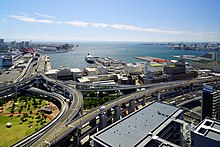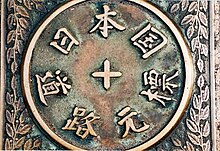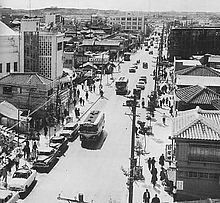Traffic in Japan


This article covers the various modes of transport in Japan .
Land transport
Road traffic
Japan has 1,852,207 kilometers of road network, of which 1,263,003 kilometers (including 14,114 kilometers of motorways) are paved. Speed limits of 80 and 100 km / h apply on the national expressways . The largest tunnel for road traffic is the Tōkyō-wan-Aqua-Line . The 10.5 km long Untersee tunnel can be reached via a bridge.
Left-hand traffic applies in Japan . A temporary exception was the right-hand traffic introduced in Okinawa under the US military government after World War II. Even after it was returned in 1972, right-hand traffic was still in effect until July 30, 1978, when at 6 o'clock in the morning it was switched back to left-hand traffic across the prefecture. After the date (7/30), the reset is also known as 730 (nana-san-maru) .
Highways
Until its division in 2005, Nihon Dōro kōdan ( 日本 道路 公 団 , English Japan Highway Public Corporation , JH for short ) , founded in 1956, was the only nationwide company responsible for the construction and operation of the last 14,114 km of motorway. The three successors of Nihon Dōro under private law share the motorway operations regionally: East Japanese , Central Japanese and West Japanese motorways . The city highways of the two largest metropolitan areas ( capital and Hanshin highways ) as well as the connecting highway between Honshū and Shikoku (Hon-Shi highway) were operated by three of their own central state kōdan , which were also formally privatized in 2005, but still owned by the public Hand are. For all highways of these four former kōdan (including newly built routes), since formal privatization in 2005, a self-governing body, called kōsokudōro kikō for short ("Motorway Organization ", JEHDRA ), takes ownership and the liabilities arising from the construction; it makes the motorways available to the six operating companies under private law against lease, with which the liabilities are settled. The operating companies, in turn, collect a toll from the motorway users. Other city highways, which are also subject to tolls, are mostly operated by regional public companies of the local authorities (prefectures or municipalities). A special case is the toll-free Tōkyō Kōsokudōro (“Tokyo Highway”), a private road that legally falls into the category ( ippan jidōshadō , “ordinary road”), which otherwise includes primarily toll panoramic roads.
What is striking about the Japanese motorway network is the frequent branching and the strong concentration on the Pacific coastal belt ( Omote-Nihon ). The hinterland is also served by expressways and motorways, but the volume of traffic is lower than in cities like Tokyo or Yokohama. The toll depends on the vehicle (car or truck) and the distance traveled. On some highways that are subject to tolls (rather seldom) the tolls start at the equivalent of around 1 euro and on motorways you have to reckon with fees of around 5 euros for the first few kilometers. For example, a route from Iruma (Saitama) to Takasaki (Gunma) currently costs 2100 yen (that's around 20 euros for the 80 km route).
Other public roads
According to the jurisdiction of the central government or local authorities, most of the public roads in Japan can be divided into three groups:
- National roads ( kokudō , 国 道 ), which in the legal sense also include national highways (jur. Kōsoku jidōsha kokudō ), from which the other national roads are distinguished as "ordinary national roads " (ippan kokudō) - in normal parlance one usually only calls the latter kokudō -,
- Prefecture streets ( to- / dō- / fu- / kendō , 都 道 府 県 道 ) and
- Municipal roads ( [ku -] / shi- / chō- / sondō [区] 市町村 道 ; the kudō , the streets of [special] districts ( tokubetsu-ku ) , are part of it, but collectively the municipal roads outside the Tokyo Prefecture are called mostly just shichōsondō ).
According to the length of the route, in 2008 of the approximately 1.2 million km in the dōro-hō ( 道路 法 , "road law"; does not include, among other things, forest, agricultural and fishing roads and private roads) regulated public roads in Japan were 84.1 % Municipal roads, 10.7% prefecture roads, 4.5% (ordinary) national roads and 0.6% national highways.
The capital for building and maintaining the road network comes from various sources. State building projects are financed from taxes on mineral oil and CNG , the prefectures use the income from the vehicle tax for local building projects.

Before the Second World War it was a legal requirement to indicate all distances relative to a "road exit marker " ( 道路 元 標 , dōro genpyō ) on the Nihombashi in Chūō , Tokyo. To this day, the bridge is the starting point for several national roads (1, 4, 6, 14, 15, 17, 20) and the reference point for distance information to Tokyo.
Motorization
The most important means of transport in passenger transport in large cities is public transport, i.e. the underground, suburban trains and buses. Intercity buses only play an important role in the few areas that are difficult to reach by rail. Owning a car outside of rural areas is linked to a parking permit ( Shakoshomei ), which costs around 30,000 yen (approx. 200 euros) once. The level of motorization is 691 vehicles per 1000 inhabitants, which is higher than in Germany. In 2016, 60.8 million cars were registered in Japan.
The Japanese car market was for a long time practically sealed off from foreign suppliers by high import duties , but today there is no longer any import tax for normal cars. Nevertheless, domestic automakers hold by far the largest market shares.
The car models that are often used as taxis are the Toyota Crown and the Nissan Cedric . The seats are usually provided with white protective covers. Taxi drivers wear white gloves and a uniform while driving. Gas stations operate under the names Shell , Esso and Eneos , among others .
Rail transport
Japan has a 27,311 km long rail network that is not connected to other countries because of its island location. There are seven railway companies that are grouped under Japan Railways and serve almost three quarters of the route network, but operate regionally independently. The rest are served by 16 large private companies and numerous smaller local lines. Four of the seven JR companies operate the Shinkansen network with high-speed trains . Japan has been the motherland of modern high-speed train technology since 1964. The Shinkansen network is separated from the rest of the railway network due to different gauges ; in some large cities the Shinkansen stations are peripheral. Numerous railway lines have been regionalized since the 1980s and are known today as so-called third - sector railways .
In Japan 11 exist subways : underground Fukuoka , subway Kobe , subway Kyoto , subway Nagoya , subway Osaka , subway Sapporo , Sendai Subway , Tokyo subway and U- Railway Yokohama .
There are numerous monorails in Japan , e.g. B. the Kitakyushu monorail , the Chiba Monorail , the Naha monorail in Okinawa Prefecture , the Osaka Monorail, the Shōnan Monorail ( Kamakura ), the Hiroshima monorail called Sky Rail , the Tama Line monorail , the Tōkyō Monorail and the Ueno Zoo monorail . There are also modern track-guided local transport systems such as Astram or Yurikamome .
The Shinjuku Station is the world's largest passenger railway station with an average daily ridership of 3,466,398 people (2005). This is followed by Ikebukuro (2,619,761 passengers per day), Osaka / Umeda (2,230,252), Shibuya (2,136,011) and Yokohama (2,050,273) stations.
See also
- Tōkaidō (historical trade route between Edo [now Tokyo] and Kyoto)
- Kaido
- Traffic in the Tokyo metropolitan area
aviation

Airlines
The two largest airlines in Japan are All Nippon Airways (ANA) and Japan Airlines (JAL), which handle all international passenger traffic. Furthermore, there are a variety of national airlines and several international cargo airlines such as Nippon Cargo Airlines with eleven freighters of the pattern 747 .
Airports
There are numerous major airports as well as a multitude of domestic and regional airports. Major international airports include: Osaka-Itami Airport , Central Japan International Airport (Centrair), Narita International Airport (Tokyo), and Kansai Airport . The fourth largest airport in the world is Tokyo-Haneda Airport , which has been increasingly handling international flights since its expansion in 2010. Due to the lack of space, artificial islands have been created for some airports.
shipping
The 22 largest seaports are administered by the Ministry of Land, Infrastructure, Transport and Tourism Transport; these are: Chiba, Fushiki / Toyama, Himeji, Hiroshima, Kawasaki, Kitakyushu, Kobe, Kudamatsu, Muroran, Nagoya, Niigata, Osaka, Sakai / Senpoku, Sendai / Shiogama, Shimizu, Shimonoseki, Tokyo, Tomakomai, Wakayiama and, Yokkaich .
Ferries operate between the numerous islands , important ferry services are Hokkaidō - Honshū and Okinawa Hontō - Kyūshū / Honshū.
swell
Web links
- www.japan-photo.de: picture galleries on the subject (Japan Photo Archive)
- Japanese Road Traffic Documents at the Ministry of Land, Infrastructure, Transport and Tourism (MLIT)
- Information about rail traffic at MLIT
Individual evidence
- ↑ Website of Nihon kōsokudōro hoyū saimu hensai kikō ( Japan Expressway Holding and Debt Repayment Agency ) (Japanese, partly English)
- ↑ Kokudokōtsūshō : 道路 行政 の 簡 単 解説 , Ⅱ. 道路 の 種類 , p. 7
- ↑ Oliver Mayer: More stagnation than hope: An overview of third-sector railways in rural Japan. In: The Bulletin of Aichi University of Education, Humanities, Social Sciences. No. 66, 2017, p. 138. Full text of the article.
- ^ Questions and Answers about the Japanese Auto Industry and the Trans-Pacific Partnership. Japan Automobile Manufacturers Association website. Retrieved April 2, 2017.


